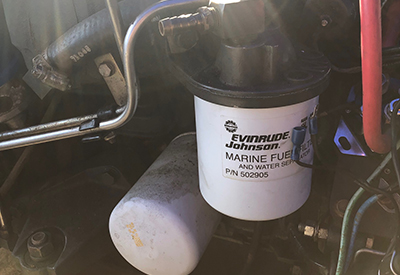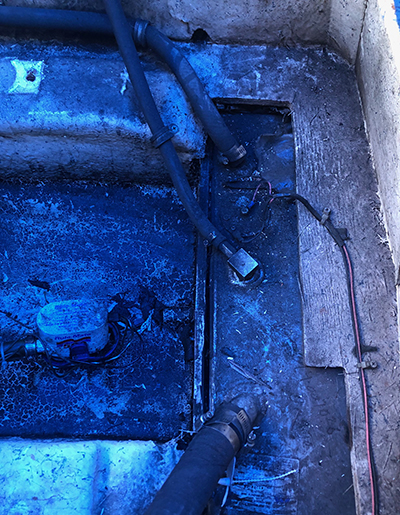Ask Andrew: Engine Fuels. Part 1 – Gas

Sept 26, 2019
A spin-on style fuel filter. This type separates water and debris from any fuel flowing through.
Engines don’t need much to run (or to stay running). When you break down even the most complicated gasoline engine – even one with modern technology including an onboard computer, diagnostics and electronic ignition – it still only needs three things: Spark, Compression and Fuel. (Diesel engines differ slightly, in that they rely on high pressure and compression, rather than a spark.)
One of the trickier aspects for marine engines in today’s world is fuel. An engine’s fuel system seems complicated – but when broken down and explained, boat owners have a much greater chance of getting through a season with no issues.
A fuel system is comprised of a few parts:
1) The fuel tank
2) Fuel Lines
3) Fuel Pump
4) Shut-off valves
5) Fuel Filter(s)
6) Delivery system
 A fuel tank with multiple hoses: the lowest hose is the tank fill. The middle hose connects to the tank pick-up tube (providing fuel to the engine) and the top hose is a vent, allowing air to move in and out of the tank as the fuel level changes
A fuel tank with multiple hoses: the lowest hose is the tank fill. The middle hose connects to the tank pick-up tube (providing fuel to the engine) and the top hose is a vent, allowing air to move in and out of the tank as the fuel level changes
It works pretty simply: When the engine is engaged, a fuel pump (either electric or mechanical) draws fuel from the fuel tank, via the fuel lines. The fuel runs through a filter, separating out water and debris, where it travels to the engine and is delivered to the engine cylinders (where all the work happens) via the carburetor or injectors.
In all of these parts the main problem encountered is fuel itself. In most boats in Canada, fuel is used for half of the year and then is left to sit in long-term storage for the winter months. Fuel breaks down over time, and is susceptible to microbial growth, and loss of octane (the ability of the fuel to ignite.)

Secondary to this is the ethanol additive that is found in many readily available fuels. Ethanol is an alcohol that is added to fuels available at the pumps to help in reducing emissions. However, alcohol additives in fuel attract water, which dilutes the fuel, creating problems for boats. Alcohols also break down gaskets, diaphragms, primer bulbs and fuel lines.
An example of a fuel stabilizer which should be added to the fuel tank (and run through the fuel lines and engine) any time the boat is in long-term storage
How do we optimize fuel and maintain our boat’s fuel system?
First: Purchase a fuel that is ethanol free. if filling up at a standard gas station, choose high-grade fuel. If at a marina, ask if they have ethanol free fuel available.
Next: When storing your boat for long periods, add a high-quality fuel stabilizer to the fuel in the tank. This will slow the loss of octane and counteract the effects of any ethanol or water. For diesel fuel, add a biocide during periods of storage
With these two steps, we can be fairly certain that the fuel itself is in good shape. Lets look at some other maintenance points:
 A marine grade fuel line, with specifications.
A marine grade fuel line, with specifications.
1) Fuel tanks – try to prevent sludge or debris from accumulating in the fuel tank. If you suspect that there is any debris or old fuel, try to keep the tanks topped up with fresh fuel and don’t allow the fuel level to get low. Inside the tank, a tube (called a pick-up) sits vertically like a straw, and allows fuel to be drawn from the bottom of the tank. At the top of the pick-up is an anti-siphon check-valve that stops fuel from continuously running out of the tank
2) Fuel lines – check fuel lines regularly for any breaks, cracks, loose hose clamps or other leaks. At the first sign of damage, replace them with an appropriate grade and diameter fuel line
3) Fuel pump – most are designed to be maintenance free – but watch for lack of pressure. A broken fuel diaphragm or a blockage in the fuel lines can cause an engine to starve and die off with lack of fuel (especially at higher speeds), or not start at all.
4) Fuel filters – check fuel filters regularly and replace them at least annually. If fuel filters accumulate water and aren’t drained or replaced, water can make it’s way into the engine. If your engine is bogging or dying off as it runs, check the fuel filter first to see if it has accumulated water.
5) Shut-off valves are a safety feature allowing the user to shut off the fuel supply to the engine, to perform maintenance or, in the case of multiple tanks, to switch between fuel tanks
6) Delivery system: fuel can be delivered to the engine via a carburetor, fuel rails and injectors. Each will deliver fuel in the correct proportion to air into the cylinders where the fuel is burned. The fuel is aspirated into the cylinders – its delivered as a fine mist. Any clogs or broken down fuel can block up passages in the carburetor or the injectors. Proper winter layout procedures and periodic carburetor and injector cleaning can keep the fuel delivery in top shape.
In summary: keep fuel fresh, limit your used of ethanol, replace fuel filters regularly and perform periodic inspections and maintenance to avoid any fuel problems!
In part two of this discussion, I will take a look at diesels both in powerboat and sail auxiliary application.
Enjoy the last month of boats before winter layup begins!
 Andrew McDonald is the owner of Lakeside Marine Services – a boat repair/maintenance firm based in Toronto. Andrew has worked in the marine industry for 12 years and is a graduate of the Georgian College ‘Mechanical Techniques – Marine Engine Mechanic’ program.
Andrew McDonald is the owner of Lakeside Marine Services – a boat repair/maintenance firm based in Toronto. Andrew has worked in the marine industry for 12 years and is a graduate of the Georgian College ‘Mechanical Techniques – Marine Engine Mechanic’ program.
Questions or comments for Andrew? Email him directly via: askandrew@lakesidemarineservices.ca




























